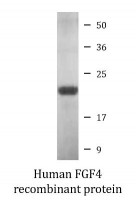ARG70111
Human FGF4 recombinant protein (Active) (His-tagged, C-ter)
Human FGF4 recombinant protein (Active) (His-tagged, C-ter) for SDS-PAGE
Overview
| Product Description | E. coli expressed, His-tagged (C-ter) Active Human FGF4 recombinant protein |
|---|---|
| Tested Application | SDS-PAGE |
| Target Name | FGF4 |
| Species | Human |
| A.A. Sequence | Gly25 - Leu206 |
| Expression System | E. coli |
| Activity | Active |
| Activity Note | Determined by its ability to induce 3T3 cells proliferation. The ED50 for this effect is < 2.5 ng/mL. The specific activity of recombinant human FGF-4 is > 4 x 10^5 IU/mg. |
| Alternate Names | K-FGF; HST-1; FGF-4; Transforming protein KS3; HSTF-1; Heparin secretory-transforming protein 1; Fibroblast growth factor 4; KFGF; HST; Heparin-binding growth factor 4; HBGF-4; HSTF1 |
Properties
| Form | Powder |
|---|---|
| Purification Note | Endotoxin level is less than 0.1 EU/µg of the protein, as determined by the LAL test. |
| Purity | > 95% (by SDS-PAGE) |
| Buffer | PBS containing 0.1% sarkosyl (pH 8.0) |
| Reconstitution | It is recommended to reconstitute the lyophilized protein in sterile water to a concentration not less than 200 μg/mL and incubate the stock solution for at least 20 min at room temperature to make sure the protein is dissolved completely. |
| Storage Instruction | For long term, lyophilized protein should be stored at -20°C or -80°C. After reconstitution, aliquot and store at -20°C or -80°C for up to one month. Storage in frost free freezers is not recommended. Avoid repeated freeze/thaw cycles. Suggest spin the vial prior to opening. |
| Note | For laboratory research only, not for drug, diagnostic or other use. |
Bioinformation
| Gene Symbol | FGF4 |
|---|---|
| Gene Full Name | fibroblast growth factor 4 |
| Background | The protein encoded by this gene is a member of the fibroblast growth factor (FGF) family. FGF family members possess broad mitogenic and cell survival activities and are involved in a variety of biological processes including embryonic development, cell growth, morphogenesis, tissue repair, tumor growth and invasion. This gene was identified by its oncogenic transforming activity. This gene and FGF3, another oncogenic growth factor, are located closely on chromosome 11. Co-amplification of both genes was found in various kinds of human tumors. Studies on the mouse homolog suggested a function in bone morphogenesis and limb development through the sonic hedgehog (SHH) signaling pathway. [provided by RefSeq, Jul 2008] |
| Function | Plays an important role in the regulation of embryonic development, cell proliferation, and cell differentiation. Required for normal limb and cardiac valve development during embryogenesis. [UniProt] |
| Cellular Localization | Secreted. [UniProt] |
Images (1) Click the Picture to Zoom In






